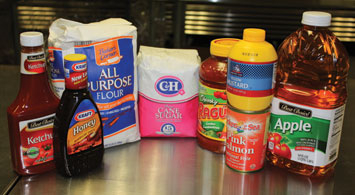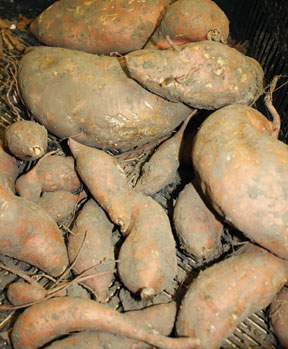 Many of us have stuffed ourselves during the past several days on latkes and brisket and other delicacies as we celebrated Chanukah. Some of us in the Jewish community are not fortunate enough to feel full during this holiday, or any other day.
Many of us have stuffed ourselves during the past several days on latkes and brisket and other delicacies as we celebrated Chanukah. Some of us in the Jewish community are not fortunate enough to feel full during this holiday, or any other day.
While the plight of the hungry has gotten a lot of press lately, it’s never enough. So several organizations — including the Jewish Council for Public Affairs, MAZON: A Jewish Response to Hunger and a variety of rabbinical and Jewish social justice organizations — organized the Jewish Community Food Stamp Challenge. The project asked participants to live for one week on the average food stamp allotment of $31.50 per person as a way to understand how difficult it is to be hungry and to demonstrate the Jewish community’s commitment to ending hunger.
Several people in the local Jewish community — including Rabbi Alexandria Shuval-Weiner of The Temple, Congregation B’nai Jehudah, Congregation Beth Torah’s Rabbi Mark Levin, JFS Executive Director Don Goldman and Rabbi Debbie Stiel of Temple Beth Sholom in Topeka — took the challenge. By doing so they put themselves on a welfare diet, seeing what it’s like to taste just a little bit of the life so many others have no choice but to lead.
The cold, hard facts
Statistics provided by JCPA note that one in six American households is struggling against hunger. Current economic turmoil and threats of severe cuts to government programs have left America’s hungry — already at historically high numbers — with little hope of relief. Recent studies by a number of agencies and organizations highlight this disturbing trend: between 2007 and 2009, the number of households struggling with hunger increased more than 33 percent with nearly one in four U.S. households with children unable to afford enough food. And the U.S. Census Bureau reported that the U.S. poverty rate rose to 15.1 percent in 2010, with one out of every six Americans, or 46.2 million, living in poverty.
Not surprisingly, with so many more in need, enrollment in federal food and nutrition programs is dramatically on the rise. In April 2012, SNAP (Supplemental Nutrition Assistance Program, formerly known as food stamps) participation rose to a record level of more than 46.2 million Americans — an increase of more than 1.5 million people compared with just one year before. But proposed cuts mean millions could be left without help.
The challenge
This is the second time that Rabbi Shuval-Weiner has chosen to eat for a week on $4.50 per day, or $1.50 per meal. That’s the average amount a SNAP participant received in 2010. This year she took the challenge in September, right before the High Holidays.
Rabbi Shuval-Weiner regularly preaches and advocates about hunger issues. But she felt it was important to actually make that sacrifice herself.
“To actually have to make that struggle I feel is a really important marker because people struggle with this every single day of their lives. For me to put myself back in that place, it was a contemplative act of re-engagement with something I feel very powerful about, which is anti-hunger advocacy,” she said.
Rabbi Levin discussed his plan to participate in the Food Stamp Challenge in a High Holiday sermon and took the challenge just before Thanksgiving. He said he had long wondered what it was like to be food insecure, the new phrase, which refers to people who have limited or uncertain access to adequate food. But until the challenge was laid, Rabbi Levin really didn’t know the best way to experience food insecurity.
By doing this, Rabbi Levin also wanted to show his support for the farm bill, which as of this writing was still hung up in Congress. The farm bill is a comprehensive piece of legislation, renewed approximately every five years, that covers a lot of issues including nutrition, food stamps and crop subsidies.
“I thought this is a very good idea to get people to sign on by saying they are willing to give up something. It’s not just a signature, it’s a commitment,” Rabbi Levin said, echoing JCPA’s statement that the Food Stamp Challenge sends “a strong message to our public officials that we need to support SNAP (food stamps) and help keep millions from hunger and poverty.”
The budget Rabbi Shuval-Weiner and JFS’ Goldman, both vegetarians, learned quickly that it’s very hard to buy fresh fruits and vegetables on such a small budget.
Rabbi Shuval-Weiner and JFS’ Goldman, both vegetarians, learned quickly that it’s very hard to buy fresh fruits and vegetables on such a small budget.
“It’s like living in black and grey all the time when you have so little choice,” Rabbi Shuval-Weiner said. “For myself, I found myself eating a lot of starchy stuff. I actually gained weight. There’s only so much rice and potatoes and pasta one can eat.”
Rabbi Levin is not a vegetarian but chooses to eat little meat. By shopping smart that week he purchased what he characterized as a “filling cereal,” as well as chicken and vegetables which he made into a large pot of soup. If he ate lunch at all, it was a small piece of fruit.
“When I was buying groceries for that week I actually told the checkout guy about it. He looked at what I bought and said people who live on food stamps don’t buy fresh vegetables. I actually lived, I think, somewhat better in some respects than most people,” Rabbi Levin said.
For Goldman, the challenge highlighted how much he personally takes his food options for granted, noting that he often pays little attention to the cost of his food choices.
“But shopping for the challenge, I went off to Aldi with $22 in hand — my budget for five days, trying to figure out how to make this work. I got some bananas and splurged on mushrooms but couldn’t make any other fruit or vegetables work. I got some cheap cereal, pasta, peanut butter and bread and quickly used up my budget,” Goldman said.
He was never hungry during the week, but admits to being unsatisfied and a bit grumpy.
“I don’t think I ended up with a healthy or balanced diet. I could have planned better and probably made a healthier diet work, but that would have taken lots of planning and shopping at different stores, something most people on food stamps aren’t able to do,” Goldman said.
Rabbi Levin often talks to people when he’s out and about and he’s often seen how people struggle to make ends meet, with little time to themselves, let alone time to shop at many different places. He points to a recent conversation he had with a cashier at the market he frequents.
“I said it’s been a long day, I’ve been working for 12 hours and I’m going home,” he said. “This person said she started at 7 a.m., too, and was still working. You can’t eat right if you do that and it’s expensive,” Rabbi Levin said.
He knows of at least one member of Beth Torah who is food insecure, and one way the budget gets stretched is by preparing as much as food as possible and not buying convenience food.
“She makes beans in a crock pot. Most of us buy them already made before we use them. And certainly sweets are not in the budget at all,” he said.
More than nutrition
Rabbi Shuval-Weiner pointed out that food is not just about sustenance.
“It is what nurtures our hearts and our minds and our souls. In many ways it brings enjoyment to life. It brings a sense of connection to one another,” she said.
She said it is simply not possible on that little amount of money for people to put quality food with flavor on the table. While the Jewish community is “exceedingly generous” when it comes to food drives, she hopes people will be able to put more thought into what they donate to our local pantries.
“As we’re stocking our own food bank, we need to consider what the things are that we like to eat in our own homes,” she said.
She suggests people become more creative when they choose their food donations.
“What would you take over to your best friend if you were preparing a meal for them?” Rabbi Shuval-Weiner asked.
She would also like the JFS Food Pantry to become “a vibrant place where there’s fresh food and there’s high quality food, not just staples.” Individuals are not able to donate fresh foods to JFS just yet, (some is available through corporate donations and the Mitzvah Garden) but JFS’s Goldman said there are other things people can donate.
“They can buy more interesting items. For example, we see a great demand so far for canned salmon,” he said. “One woman was so excited to find a can of salmon and was thinking how she could stretch this to two meals for her family.”
When the challenge was over for Goldman, he was relieved that he could eat what he wanted.
“Real people on food stamps don’t get that kind of quick relief. And in fact, I spent more than my week’s budget at a lunch out with my daughter the next day. That’s something people who are on food stamps or visit our pantry don’t get to do,” he said.


